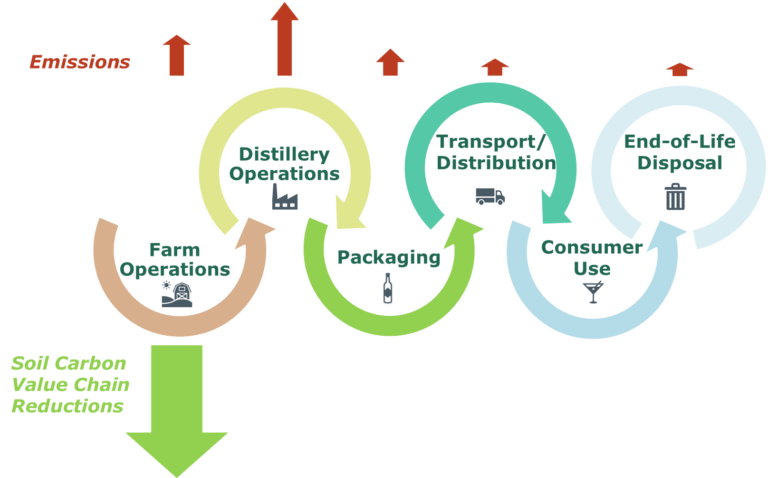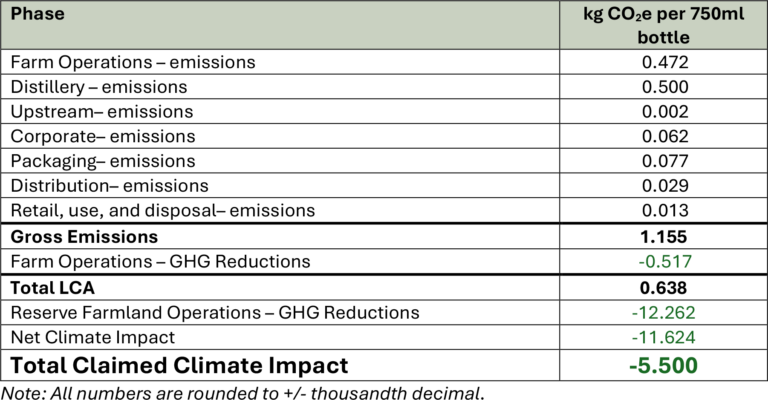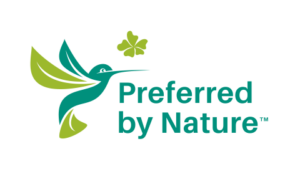2023 GHG Footprint Summary Report
Published 28 May 2025
This document presents a summary of analysis carried out by EarthOptics to determine greenhouse gas emissions arising from the production and consumption of Copalli Rum in 2023.
SUMMARY
Copalli Rum crafts its three-ingredient rum in Belize using: (1) fresh pressed, organic heirloom sugarcane sustainably and locally grown using regenerative practices, (2) pure, filtered rainwater, and (3) yeast. All agriculture, processing, distillation, production, aging, bottling, and packaging take place in Southern Belize. The distillery was designed as a closed loop system and is powered by biomass in part derived from spent sugarcane. Organic waste products are recycled on-premises into fertilizer for the cane fields. The design of the facility contributes to its low GHG emissions and overall sustainability. Copalli Rum engaged EarthOptics to perform a comprehensive cradle-to-grave, product-level, GHG Life Cycle Assessment (LCA). This LCA measured the GHG emissions associated with producing and distributing each bottle of rum and atmospheric carbon reductions occurring in our sugarcane fields. EarthOptics also measured soil carbon reductions occurring in Copalli’s other agricultural areas. The 2023 LCA and related soil carbon methodology was verified by Preferred by Nature in 2024.
For the 2023 production year, this analysis shows that each bottle of Copalli Rum generates 1.155 kilograms of GHG emissions per bottle, measured as carbon dioxide equivalent (CO2e).
The LCA also measures GHG reductions: after accounting for those reductions in the sugarcane fields, the verified LCA reports a carbon footprint of 0.638 kg of CO2e per 750ml bottle.
Factoring in GHG reductions occurring in Copalli Rum’s other agricultural areas — using the soil carbon measurement methodology verified by Preferred by Nature—the net result is negative greenhouse gas emissions of -5.500 kg CO2e for each bottle of Copalli Rum, or better.
For 2023, the actual GHG emissions are net -11.624kg CO2e per 750ml bottle. Copalli is basing its claim of -5.500 kg CO2e on a conservative assessment. When forecasting business growth and increases in rum production, Copalli expects a net GHG footprint of at least -5.500 kg CO2e per bottle for the next five years. Copalli Rum intends to repeat this LCA analysis annually using a consistent methodology to support comparability. However, future LCA results may vary depending on differences in production volume, on-the-ground conditions, and/or measurement of additional carbon reductions not measured for 2023.
Methodology
For the 2023 LCA (completed in 2024, for the 2023 production year) EarthOptics evaluated Copalli Rum’s GHG footprint from raw material extraction to end-of-life disposal following widely accepted, independent, international standards. These include the Greenhouse Gas Protocol 1 and its Product Standard, ISO 14040/14044 2, and PAS 2050 3. Total emissions were measured for the company, including corporate emissions attributable to Copalli Rum operations. Emissions reductions also were measured using state of the art soil science and year-over-year measurement and analysis to demonstrate the additional soil carbon removal and storage occurring in Copalli Rum’s (i) sugarcane fields and (ii) other agricultural areas. These totals were then extrapolated across actual production volumes for 2023, using 750ml bottle equivalent, to arrive at per-bottle GHG emissions data.
Copalli Rum oversees every point in the value-chain before the bottled rum leaves the facilities in Belize. This integration of farming, production, and packaging enables Copalli Rum to track data accurately. EarthOptics used raw business activity data gathered by Copalli Rum staff for the 2023 production year, then applied that data using the approaches and methodologies in the LCA standards noted above. GHG emissions occurring beyond the Copalli Rum distillery gate also were calculated with a high degree of confidence utilizing data from the downstream supply chain and supplemented by additional industry and academic, well-recognized sources. Accepted emissions factors were employed where needed to convert raw data (for example, fuel consumption) into GHG emissions. In line with the comprehensive and cradle-to-grave nature of LCA, all GHG emissions from sugarcane production and supply chain through end-of- life disposal, including corporate emissions attributable to Copalli Rum’s operations were assessed.
EarthOptics evaluated soil carbon stocks to measure atmospheric GHG removals occurring during 2023 in the sugarcane fields and adjacent agricultural areas. Year-over-year soil carbon data was compared to arrive at final GHG removal values. Soil sampling was conducted on-site using proven methodologies, with samples analyzed by an independent laboratory. Baseline sampling occurred in 2023, with resampling in 2024. The organic carbon concentration and bulk density measurements were combined to estimate soil carbon density in the 0-30 cm layer of soil. Statistical methods were applied to derive the year-over-year GHG reduction values.
The LCA, as verified by Preferred by Nature, arrived at GHG emissions of 0.638 kg of CO2e per 750ml bottle. When applying additional GHG reductions attributable to areas of Copalli Rum’s additional sugarcane farmland reserve, the net result is negative greenhouse gas emissions of at -11.624 kg/CO2e per 750ml bottle of Copalli Rum. This emissions netting process (accounting for both emissions and reductions) is a feature of how a LCA is conducted under the Greenhouse Gas Protocol; applying additional GHG reductions from the related operational or supply chain boundary is sometimes referred to as “insetting.”
1 The GHGP Product Life Cycle Accounting and Reporting Standard enables assessment of the life cycle emissions of a product and a focus on the greatest GHG reduction opportunities. https://ghgprotocol.org/
2 The ISO 14040 series standards, Life Cycle Assessment, address quantitative assessment methods for the assessment of the environmental aspects of a product or service in its entire life cycle stages. ISO 14040 is an overarching standard encompassing all four phases of LCA.
3 Publicly Available Specification (PAS) 2050 is a specification for the assessment of the life cycle GHG of goods and services.
Scope of analysis
EarthOptics measured the GHG emissions from raw materials extraction (largely sugarcane production) to end-of-life disposal (cradle-to-grave) for producing one bottle of Copalli Rum.
The following phases of Copalli Rum’s production process were identified:
- Farm Operations
- Distillery Operations (including relevant corporate emissions)
- Upstream inputs
- Packaging
- Distribution
- Use
- Disposal
GHG Impact on phases of a product lifecycle

*Note: Arrows in this graphic are not to scale but serve as a visual representation of the level of emissions generated and reduced.
Life Cycle Analysis - Core Considerations
Farm Operations
Copalli Rum uses heirloom sugarcane sustainably and locally grown using regenerative and organic practices. Through using regenerative agriculture practices that avoid field burning and synthetic fertilizers, pesticides, and herbicides, Copalli Rum has much lower impact during the farming process as compared to industrial sugarcane cultivation. Carbon captured in the air from sugarcane is then stored in the plants themselves and in the soil in the ground. The carbon impact of Copalli Rum’s regenerative practices was measured through comprehensive, on-the-ground soil sampling. Samples were sent to a lab that ran tests and sent results to EarthOptics, who analyzed and quantified the amount of additional carbon in the soil, which was then extrapolated over the entire sugarcane farm areas as well as the reserve farmland. Fuel used by farm equipment was the primary source of GHG emissions from the farm.
Distillery Operations
The distillery was designed to ensure that waste is minimized and resource use optimized throughout the production and consumption cycle—in line with principles of circularity. Leftover biomass from cane juice extraction (bagasse) is used to fire the boiler. Liquid by-product of distillation (vinasse) is combined with boiler ash and chicken manure to fertilize the fields. Distillery emissions in 2023 include fuel use, biomass supply, water distillation and consumption, electricity consumption, and residual waste. GHG emissions related to biomass combustion, electricity, and fuel use were estimated using volumes of inputs and applicable emissions factors. Waste, distillation, and other emissions also were calculated using distillery data and emissions factors.
Upstream
Emissions from miscellaneous upstream inputs (barrels, yeast, capital expenditures, etc.) were also included in the 2023 LCA relying on distillery data for the inputs and related emission factors.
corporate emissions
Copalli Rum decided to go above and beyond international standards by including its corporate emissions determined based on revenue allocation in its 2023 per bottle LCA.
Packaging
Bottling and packaging is performed onsite at the distillery. In 2023, this process was performed by hand, without the use of GHG-emitting machinery. Packaging includes bottles, corks, shipper/divider material, and labels. Data on these elements was collected and used to calculate packaging emissions. Copalli Rum intentionally does not use any secondary packaging, gift boxes, or inserts.
Distribution
EarthOptics calculated transport and distribution emissions using Copalli Rum’s shipment data for 2023 based on distances, shipment routes, and known means of transportation.
Consumer Use
Consumer use is part of a full product lifecycle. Due to the nature of a spirits product like Copalli Rum, there are no associated GHG emissions to consumer use of the product. Packaging disposal (bottles) was accounted for.
End-Of-Life Disposal
EarthOptics estimated emissions derived from primary sales data, including information on where bottles were shipped in 2023 and landfill and recycling practices in those locations.
2023 Carbon Footprint Summary by Activity

Copalli is basing its per-bottle claim of -5.500 kg CO2e on a conservative assessment. When considering forecast business growth and increases in rum production, Copalli expects a net GHG footprint of -5.500 kg CO2e per bottle (or better) for the next five years. Copalli Rum intends to repeat this LCA analysis annually using a consistent methodology to support comparability. However, future LCA results may vary depending on differences in production volume, on-the-ground conditions, and/or measurement of additional carbon reductions not measured for 2023. The claim of -5.5kg CO2e accounts for all these variables.

ABOUT EARTH OPTICS
EarthOptics is a commercial soil data measurement and mapping company (www.earthoptics.com) creating accurate data maps – including compaction, carbon, moisture, nutrients, soil health and more – that deliver insights needed to unlock the full potential of soil. Since our founding in 2018, EarthOptics has served federal, state, local government and commercial agricultural and grasslands customers in research, production, and measurement and verification capacities. Key partners include ecosystem service providers, technical service providers, equipment and sensor manufacturers, universities, food companies, and nonprofit organizations.
EarthOptics’s proprietary sensor technology and data analytics make intelligent soil data accessible on a large scale for increased agricultural yields, carbon market acceleration, and improved land management and environmental stewardship. Coincident with laboratory soil samples, EarthOptics conducts vehicle-based digital sensor measurements to create a complete analysis set. The EarthOptics GroundOwl™ sensor suite measures soil compaction to a depth of several feet, while also measuring changes in soil texture, carbon content, conductivity, and nutrient properties. The digital data is analyzed with a patented machine learning platform and this combination of laboratory and digital scan data enables the measurement of soil parameters at high resolution using one-third or fewer lab samples than traditional soil sampling methods, dramatically improving affordability while maintaining accuracy. The company’s success to date is based not only on the accuracy and high resolution of the soil maps, but also on EarthOptics’s ability to effectively work with land managers, project managers, and technical partners across a spectrum of projects from research to MRV of carbon credits. EarthOptics’s accuracy is trusted by both producer and consumer groups.

ABOUT PREFERRED BY NATURE
Preferred by Nature is an international non-profit organization working to support better land management and business practices that benefit people, nature, and climate. PBN does this through a unique combination of sustainability certification services including carbon verification, projects supporting awareness raising, and capacity building. For nearly 30 years, PBN has worked to develop practical solutions to drive positive impacts in production landscapes and supply chains in 100+ countries. PBN focuses on land use, primarily through forest, agriculture, and climate impact commodities, and related sectors such as tourism.

